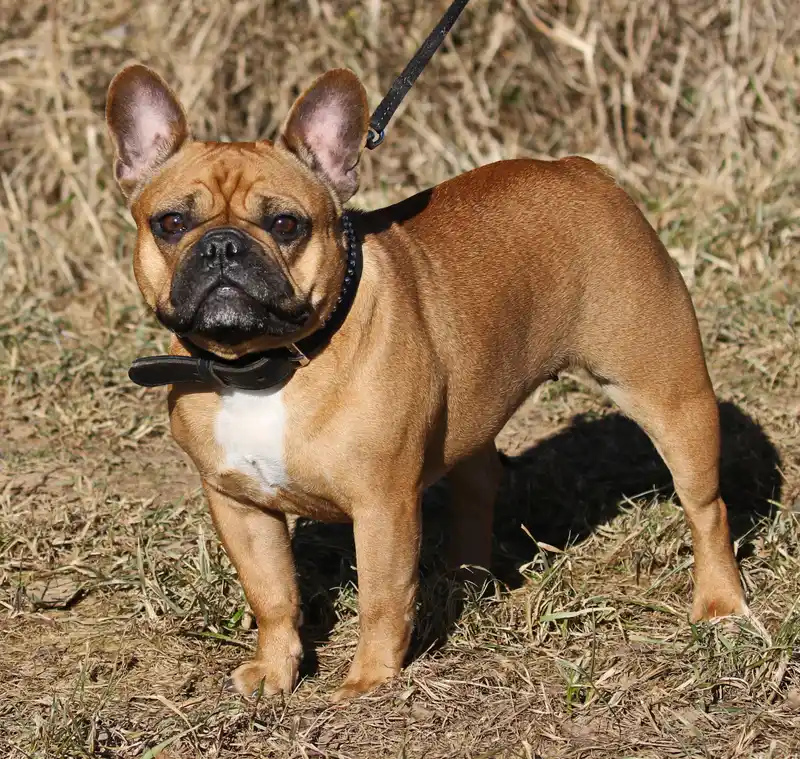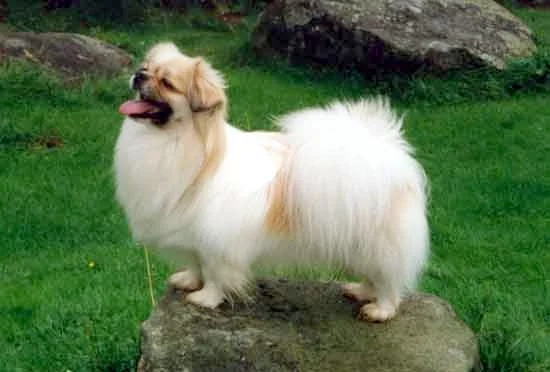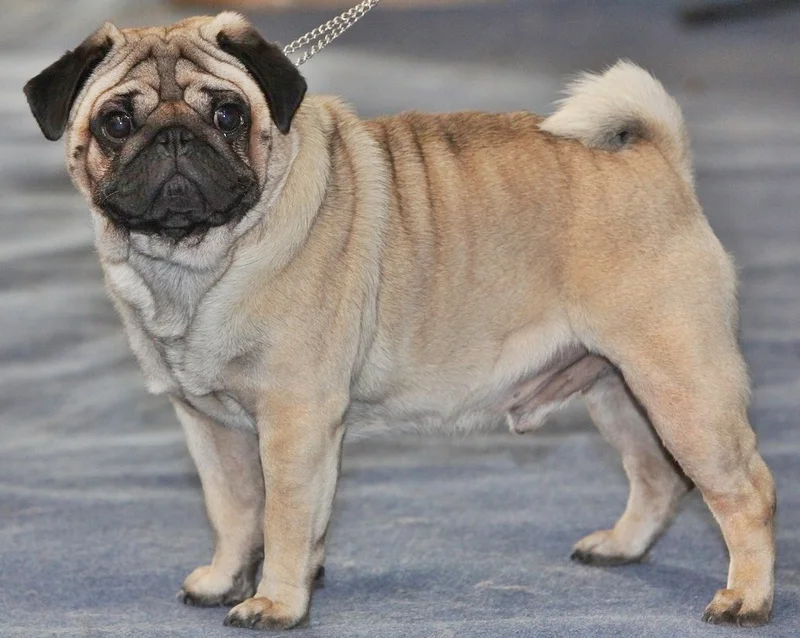Bulldog
The Bulldog is a medium-sized, muscular breed known for its wrinkled face and gentle temperament. They are affectionate, good with children, and require moderate exercise.
Overview
🐕Breed Overview
✨Key Traits
💡What Makes Bulldog Special
Bulldogs are characterized by their unique appearance and amiable personality. Their stocky build and wrinkled face give them a distinctive look that many find endearing.
They are known for their loyalty and protective instincts, often forming strong attachments to their families. Bulldogs are not overly active, making them suitable for apartment living, but they still require regular exercise to maintain a healthy weight.
Their gentle nature makes them great companions for children, and they are often described as 'clowns' for their playful antics. Bulldogs are also known for their stubbornness, which can make training a challenge, but with patience and consistency, they can learn a variety of commands and tricks.
The Bulldog, often referred to as the British Bulldog, is a medium-sized breed known for its muscular build, distinctive wrinkled face, and gentle demeanor. With a history rooted in bull-baiting, this breed has transformed into a beloved companion known for its loyalty and affectionate nature. Bulldogs are characterized by their broad heads, short muzzles, and stocky bodies, making them easily recognizable.
They typically weigh between 40 to 50 pounds and stand about 12 to 15 inches tall. Despite their tough appearance, Bulldogs are known for their calm and friendly temperament, making them excellent family pets. They are particularly good with children and tend to form strong bonds with their human companions.
Bulldogs require moderate exercise, such as short walks and gentle play, to maintain their health and prevent obesity. Their grooming needs are minimal, but regular cleaning of their facial wrinkles is essential to prevent skin infections. Bulldogs are sensitive to heat due to their brachycephalic structure, so owners must take precautions during hot weather.
Overall, Bulldogs are charming, comical, and devoted companions that thrive in family environments. Their unique personalities and gentle nature make them a popular choice for dog lovers around the world.
🎉Fun Facts
Bulldogs are known for their distinctive wrinkled faces and pushed-in noses.
Bulldogs are prone to snoring and heavy breathing due to their brachycephalic structure.
They are often referred to as 'gentle giants' due to their calm demeanor despite their muscular appearance.
They are one of the most popular mascots for universities and sports teams, symbolizing strength and loyalty.
Breed Characteristics
Family & Friends
Good Behavior
Get Up & Go
Household Harmony
Temperament & Personality
✨Key Traits
🐕Core Temperament
Bulldogs have a calm and friendly temperament, making them excellent family pets. They are known for their loyalty and protective nature, often forming strong bonds with their human companions.
Bulldogs are generally good with children and can be friendly towards strangers, although some may exhibit a stubborn streak. They are not aggressive by nature, and breeders have worked to enhance their gentle disposition.
Socialization from a young age is important to ensure they are well-adjusted and comfortable around other dogs and pets.
💫Personality Profile
Bulldogs are known for their gentle and affectionate nature. They are typically calm and easygoing, making them excellent companions for families.
Despite their stubborn streak, they are eager to please and respond well to positive reinforcement training. Bulldogs enjoy being around people and often form strong bonds with their families.
They are generally good with children and can coexist peacefully with other pets, although early socialization is important. Their playful yet relaxed demeanor makes them a joy to have around, and they often prefer lounging on the couch to engaging in vigorous play.
🔊Vocal Tendencies
Bulldogs are known for their vocalizations, which can include snoring, wheezing, and occasional barking. They tend to bark when alerting to strangers or during play, but they are not excessive barkers.
Their brachycephalic nature contributes to their unique sounds, often leading to heavy breathing and snoring, especially when relaxed or sleeping. While they may not be the quietest breed, their vocalizations are generally manageable and often endearing to their owners.
Affection & Social Traits
Energy & Activity
Communication Style
Care Requirements
🏃♂️Exercise Requirements
Daily Exercise
Bulldogs require moderate exercise to maintain their health and prevent obesity. A daily walk of about 20 to 30 minutes is ideal, but they should not be overexerted, especially in hot weather due to their brachycephalic nature. Activities like short walks, gentle play sessions, and light fetch games are suitable.
Puppies should engage in short bursts of play, while adult bulldogs benefit from consistent, low-impact exercise. Senior bulldogs may require even less activity, focusing on gentle strolls. Regular exercise helps manage weight, supports cardiovascular health, and enhances overall well-being.
Insufficient exercise can lead to weight gain, joint stress, and behavioral issues such as boredom or anxiety.
Preferred Activities
🏠Living & Adaptability
Space Requirements
Bulldogs adapt well to various living environments, including apartments and homes with small yards. They do not require extensive outdoor space but benefit from a secure area for short play sessions.
Owners in smaller spaces should ensure regular outdoor walks and mental stimulation to prevent boredom. Due to their low activity levels, bulldogs can thrive in confined spaces, but they should not be left alone for long periods as they can become anxious or destructive.
Climate Preference
🍲Feeding Guide
Schedule
Food Types
Portion Size
Special Nutritional Needs
Bulldogs may have specific dietary needs due to their predisposition to obesity and certain health issues. A balanced diet rich in protein and low in fillers is recommended.
Owners should monitor their dog's weight and adjust food portions accordingly. Some bulldogs may have food sensitivities, so it's important to choose high-quality food and consult with a veterinarian for personalized dietary recommendations.
✨Grooming Requirements
Grooming Overview
Bulldogs have short, smooth coats that require minimal grooming. Regular brushing is recommended to remove loose hair and keep the coat healthy.
Special attention should be given to the facial wrinkles, which should be cleaned daily with a damp cloth to prevent moisture buildup and skin infections. The ears should also be checked regularly for dirt and wax buildup.
Bulldogs do not require frequent baths unless they become dirty or smelly, as over-bathing can strip their skin of natural oils. Nail trimming should be done regularly to keep their paws healthy.
Care Schedule
Brush weekly, bathe as needed, clean facial wrinkles daily, trim nails every 2-4 weeks.
Health Profile
⚕️Health Care
Regular veterinary care is crucial for bulldogs to monitor their health and catch any issues early. Routine check-ups, vaccinations, and preventive treatments are essential for maintaining their well-being.
Owners should also be vigilant about their bulldog's weight and overall health, as obesity can lead to serious health complications. Early detection and management of health issues can significantly extend a bulldog's lifespan.
Health Issues Overview
⏳Average Lifespan
Genetic Factors
Genetics play a significant role in the bulldog's lifespan, with certain hereditary health issues impacting their longevity. Responsible breeding practices that prioritize health and genetic diversity can help reduce the prevalence of common health problems. Potential owners should seek breeders who conduct health testing and are committed to improving the breed's overall health.
Living Conditions
Bulldogs thrive in stable environments with moderate temperatures. They are sensitive to heat and should be kept cool during hot weather.
A comfortable living space with access to shade and water is essential for their well-being. Regular social interaction and mental stimulation contribute to their happiness and longevity.
Bulldogs do not require extensive exercise, but daily walks and playtime are important to maintain a healthy weight and prevent obesity-related health issues.
🏥Common Health Issues
Brachycephalic Obstructive Airway Syndrome (BOAS)
Warning Signs
🔬Diagnosis
Veterinary examination, often including imaging studies to assess airway structure.
💊Treatment
Surgical intervention may be necessary in severe cases.
📝Management Tips
Maintain a cool environment, avoid strenuous exercise, and monitor for breathing difficulties.
Hip Dysplasia
Warning Signs
🔬Diagnosis
X-rays to assess hip joint conformation.
💊Treatment
Weight management, pain relief medications, and surgery in severe cases.
📝Management Tips
Maintain a healthy weight, provide joint supplements, and avoid excessive exercise.
Cherry Eye
Warning Signs
🔬Diagnosis
Veterinary examination of the eye.
💊Treatment
Surgical intervention.
📝Management Tips
Surgical correction is often needed to reposition the gland.
Skin Infections
Warning Signs
🔬Diagnosis
Veterinary examination and skin scrapings.
💊Treatment
Topical or oral antibiotics as prescribed by a veterinarian.
📝Management Tips
Keep wrinkles clean and dry, and monitor for signs of irritation.
🛡️Preventive Care
🔬Hip Evaluation
Hip Evaluation assesses the hip joint for dysplasia and other abnormalities, crucial for bulldogs due to their high prevalence of hip issues.
📅 Annually after 2 years of age.
🔬Eye Examination
Eye Examination checks for common eye conditions such as cherry eye and entropion, which are prevalent in bulldogs.
📅 Annually.
🔬Cardiac Evaluation
Cardiac Evaluation screens for heart conditions that bulldogs are prone to, ensuring early detection and management.
📅 Every 1-2 years after 5 years of age.
Training
🧠Intelligence & Trainability
💪Work Drive
Bulldogs do not have a strong work drive compared to other breeds. They enjoy tasks that involve companionship and light activities rather than strenuous work.
Engaging them in simple games, puzzle toys, and social interactions can help keep their minds stimulated. Regular, gentle exercise is important to prevent boredom and maintain their overall health.
⚠️Training Considerations
Bulldogs can be stubborn and may resist training if not motivated properly. Their low energy levels can make them less enthusiastic about exercise, leading to challenges in encouraging regular activity.
Socialization is crucial, as some bulldogs may show aggression towards unfamiliar dogs. To overcome these challenges, owners should use positive reinforcement techniques, such as treats and praise, to encourage desired behaviors.
Consistent training and early socialization can help mitigate potential behavioral issues.
📝Training Tips
Training a bulldog requires patience and consistency. Start with basic commands and gradually introduce more complex tasks.
Use positive reinforcement methods, rewarding good behavior with treats and praise. Keep training sessions short and engaging to maintain their interest.
Socialization with other dogs and people is essential, especially during puppyhood, to ensure they develop into well-rounded adults. Consider enrolling in obedience classes to enhance training effectiveness and provide social interaction.
History & Heritage
📜Origin Story
The bulldog's origins can be traced back to the British Isles, where it was bred for bull-baiting. The term 'bulldog' first appeared in literature around 1500, with the breed gaining notoriety for its role in this brutal sport.
As bull-baiting became illegal, the breed faced decline, but dedicated breeders worked to preserve its unique traits while promoting a gentler temperament. The bulldog's popularity surged in the late 19th century, leading to its recognition as a cherished companion and symbol of British culture.
⏳Development History
The bulldog's history dates back to the 13th century, originally bred for bull-baiting, a cruel sport that involved dogs attacking tethered bulls. Following the ban on bull-baiting in 1835, breeders focused on creating a gentler companion dog, leading to the modern bulldog's development.
The breed underwent significant changes in temperament and appearance, becoming more amiable and less aggressive. The Bulldog Club was established in 1875, and the breed was officially recognized by the AKC in 1886, marking its transition from a working dog to a beloved family pet.
🛡️Purpose & Historical Role
Originally bred for bull-baiting, the bulldog's role evolved significantly after the sport was banned. It became a loyal companion and family pet, known for its gentle nature and strong bonds with children. Today, bulldogs are primarily kept as companion animals, excelling in roles that require loyalty and affection.
🏺Cultural Significance
The bulldog is a symbol of British tenacity and courage, often associated with Winston Churchill during World War II. Its image has been used in various cultural contexts, representing strength and determination. Bulldogs are also popular mascots for many universities and institutions, including Yale University and the United States Marine Corps, showcasing their status as beloved companions and symbols of loyalty.
Conservation Status
This breed is well-established with healthy population numbers.









